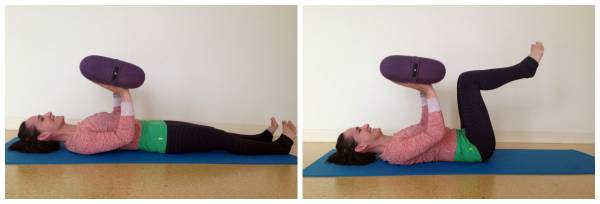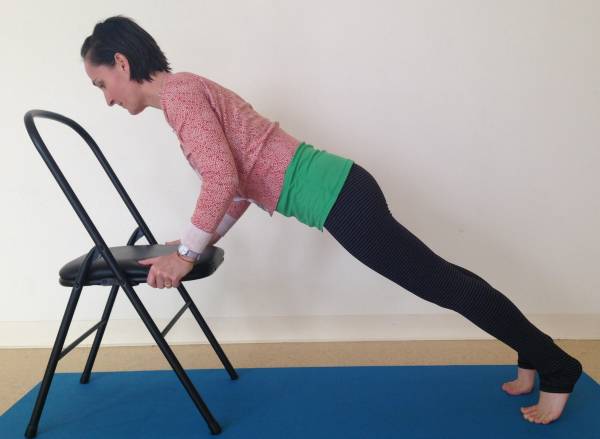I like to get to know someone a little bit before I get to know their chaturanga. It can be a sensitive subject. Often, two yogis will imagine it in two totally different ways, but both will be sure their way is certain.
And, like most things when we’re certain, change is slow to come by. However, in this case, change might be just the thing needed to keep chaturanga pain free and productive.
The Sheer-Will Chaturanga
The funny thing about chaturanga is that it’s a pose that’s typically a product of initial habits and related strength – not a product of thoughtful precision. Many people are not in the business of regularly supporting their body weight with their arms when they participate in their first flow class. Therefore, first-time four-limbed staff poses are often the result of sheer will mixed with overuse of the upper traps and reliance on the connective tissue capsule of the rotator cuff.
“Many people are not in the business of regularly supporting their body weight with their arms when they participate in their first flow class.”
As we practice, we grow stronger and more able to hold ourselves aloft, but the kicker is that the process is developmental. Initial strength gains in chaturanga are often ones that support the movement pattern we first used to manage the pose in our early days of flow-based yoga, those sheer-will days. And typically, these early patterns are not sustainable.
My chaturanga.
Take a Step Back
Usually, we don’t approach the pose step by step, slowly adding weight. Instead, we go at it all or none. I notice that when I use that philosophy with anything, I often run into a spot where I have to go backward and make a few changes in order to move on or make improvements (like the time I starting marketing a business on the radio before I had the business running).
Let’s consider how to take that step back so we can move forward in the practice of chaturanga:
- Challenge your perception and internal rules of the pose
- Change your relationship with gravity
- Increase the weight slowly
Your idea of what chaturanga is or isn’t, what it’s supposed to look like or not, and who taught you how to do it are among many of the semiconscious contributors to your view of the pose. Two common mental pictures of this pose come from the shoulder blades. We are directed to make the shoulder blades move both in and out. But these are two opposite things, so when you hear something like this in yoga, it is time to employ your imagination and a healthy dose of common sense.
Use Your Imagination
Common sense tells us the shoulder blades cannot do both things, so something is fishy. Imagination helps us to solve the mystery. See for yourself. Stand up tall with your arms by your sides. Bend the elbows so the forearms are parallel to the floor, with palms facing each other. Right now you are making the shape of chaturanga in the air, save your hands. Imagine carrying something heavy in your hands. I like to imagine I’m carrying firewood and that I’m camping. You might not like camping, so imagine something else.
“Remember the cues to any pose are just that – guideposts to help you along the way, and nothing more. The real work is in your body.”
Think we are moving further from the answer by going camping? We aren’t. Imagine the wood is quite heavy, nearly half your weight. See what it feels like to roll your shoulders forward and move the shoulder blades apart as you imagine the weight. To me, this irritates my mid back. You might be different. Then, see what it feels like to roll your shoulders back as if making the shoulder blades kiss and then imagine the weight. Ouch, that is strong in the lower back. Now, find the place you can carry the wood and you feel strong and stable. We’re on to something.
Okay, so notice the spot that felt the best. Was it what you thought? Is it where you normally go in the shoulders? Challenge a few other beliefs this way. Don’t just take my word for it. Try this air chaturanga with a few other commonly taught ideas. How does it feel if you press the shoulders down the back? Lift ‘em up towards the ears? In between? How about the elbows, how does it feel if you hug ‘em in, let ‘em fly out, or keep ‘em in between? Imagine your felt answers are more than just your imagination.
Add Some Weight
Now add some weight. The key is only to add a little, this way you get feedback from the shoulders without the risks of full chaturanga. Start with a wall. Stand a few feet away, add a slight bend to your elbows (to protect the wrists in this position), and place your hands on the wall. Lift the heels a small amount to engage the legs. Now try out your answers from the previous exercise. An important thing to remember about chaturanga is that it is a staff. The trunk and spine stay in a fixed position while the elbows bend.
Consider the same activity but on your back. Lie down on your back with bent knees and feet flat. Bring the arms to a chaturanga postion and place a bolster or light stiff object across the hands. Practice straightening the arms and bending the elbows and notice how much of the shoulder needs to stay on the floor and how much can lift. To make it more like the real thing, lift your feet, with your thighs perpendicular to the floor so that you feel your core.

Left: Supine chaturanga with legs extended; Right: With feet lifted to activate the core
When the previous exercises feel good and you have a sense of what makes sense, increase the weight by placing your hands on a table or bed frame. Try holding chaturanga here or moving slowly in and out of the pose. Continue this version for a week or so until it feels relatively easy. Then reduce the incline by placing the hands on wooden blocks (foam sags and can create wrist pain) or something similar and repeat the process slowly.

Try holding chaturanga at an incline or moving slowly in and out of the pose.
A Mini Practice
Once you’ve given your chaturanga a makeover from the top down, bring it into your practice as a practice and not as a flowing flyby. Try this pattern: kneeling plank to a small chaturanga to half child’s pose and back to kneeling plank. Consider holding the pose for a breath.
Keep your senses turned all the way up as you practice. If you aren’t getting stronger, you might be “shelving yourself” by using your arms as a shelf or moving too quickly. If you experience headaches, pain in the front of the shoulder or outer elbow, or tight upper traps, take a step back to the beginning of the process.
Your Body Has the Answers
Think you’re imagining new things you haven’t been directly told? You are. It’s a good place to be. Remember the cues to any pose are just that – guideposts to help you along the way, and nothing more. The real work is in your body. The real answers are there.
Keeping your mind in open, honest communication with your body is key. Honoring that link more often might lessen our chaturanga opposition and increase individual understanding. I mean, all said and done, we could argue that this yoga stuff is all about union in the first place, right?
You’ll Also Enjoy:
- The Sun Salutation: It’s Not Just a Warm Up
- Posture Perfect: Why It’s Okay to Be Different In Yoga
- Feet Are Our Foundation: 5 Ways to Strengthen Them
- What’s New On Breaking Muscle Today






